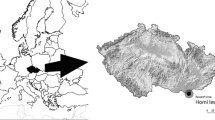Summary
A model was developed to examine the ESS sapling growth waiting for future gap formation under closed canopy. Assumptions are: a sapling has two parts, a trunk and a photosynthetic part, and allocates annual photosynthates to these two parts; and a sapling with a larger photosynthetic part has a larger production rate, but a sapling with a larger trunk is more successful in competition after gap formation. The ESS growth schedule of a sapling typically consists of three phases: (1) the sapling first allocates all annual photosynthates to the photosynthetic part, then (2) it allocates annual photosynthates both to its trunk and to photosynthetic part, and both parts grow simultaneously, and finally (3) it also allocates annual photosynthates to both parts, but the size of the photosynthetic part stays constant due to annual loss, and only the trunk size increases. A sapling should allocate photosynthates more to the trunk if mortality or probability of gap formation is large. However, a sapling should allocate photosynthates more to the photosynthetic part if large trunks are strongly advantageous in competition after gap formation.
Similar content being viewed by others
References
Canham, C.D. (1985), Suppression and release during canopy recruitment inAcer saccharum.Bull. Torrey Bot. Club. 112, 134–45.
Canham, C.D. (1989) Different responses to gaps among shade-tolerant tree species.Ecology 70, 548–50.
King, D.A. (1990) Allometry of saplings and understorey trees of a panamanian forest.Funct. Ecol. 4, 27–32.
King, D.A. (1991a) Correlations between biomass allocation, relative growth rate and light environment in tropical forest saplings.Funct. Ecol. 5, 485–92.
King, D.A. (1991b) Tree allometry, leaf size and adult tree size in old-growth forests of western Oregon.Tree Physiol. 9, 369–81.
Kohyama, T. (1987) Significance of architecture and allometry in saplings.Funct. Ecol. 1, 399–404.
Kohyama, T. (1991) A functional model describing sapling growth under a tropical forest canopy.Funct. Ecol. 5, 83–90.
Kohyama, T. and Hotta, M. (1990) Significance of allometry in tropical saplings.Funct. Ecol. 4, 515–21.
Yoda, K. (1974) Three-dimensional distribution of light intensity in a tropical rain forest of West Malaysia.Jpn. J. Ecol. 24, 247–54.
Zobel, D.B. and Antos, J.A. (1991) Growth and development of natural seedlings ofAbies andTsuga in old-growth forest.J. Ecol. 79, 985–98.
Author information
Authors and Affiliations
Rights and permissions
About this article
Cite this article
Sakai, S. Evolutionarily stable growth of a sapling which waits for future gap formation under closed canopy. Evol Ecol 9, 444–452 (1995). https://doi.org/10.1007/BF01237766
Issue Date:
DOI: https://doi.org/10.1007/BF01237766




